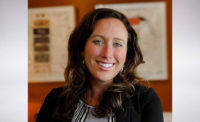Name/Title/Company: Brittany Fiema, principal, mechanical engineer, SmithGroup
Age: 34
Educational Experience: Bachelor’s degree in architectural engineering, Pennsylvania State University
Professional Credentials/Accreditations: Professional engineer (P.E.), Leadership in Energy and Environmental Design Green Associate
Organizational Affiliations/Achievements/Awards: ASHRAE Detroit Chapter president 2022-2023 and 2023 ASHRAE Chapter Service Award recipient
What does your day-to-day job entail?
My day-to-day job falls into three categories: study, design, and implementation. Lately, my studies have involved campus-scale, geo-exchange plant design and the impact of low-temperature heating hot water systems on existing buildings. Outside of geo-exchange systems, I design HVACR systems for cultural and higher education clients. I couldn’t move through the design phase of a project without my go-to tools: a ductulator, hydronic pipe sizer, psychrometric chart, and a captivating Excel doc. The implementation bucket has me out in the field, monitoring construction and brainstorming on-site design solutions.
What caused you to/when did you fall in love with engineering?
I credit my passion for sustainability to the '90s television show “Captain Planet and the Planeteers.” I like to identify engineers as the modern day Planeteers, with a responsibility to creatively reduce humans’ impact on our world’s natural resources. My love for the engineered environment originated with my fascination with the children’s book “Richard Scarry’s Busy, Busy Town,” which helped the world make sense in my toddler brain. No longer was electricity some magical element that zapped into my home; it started on a coal train — how cool!
What has been the most rewarding/proudest aspect of your engineering career?
The proudest aspect of my career is being able to visit completed projects with my family. My first net-zero energy project — the Edsel and Eleanor Ford House Administration Building and Visitor Center — is set on a beautiful historic landscape. I love walking the serene grounds in the warmer months with my husband and two daughters. In the winter, we celebrate in the holiday festivities there.
What challenges do women face in this profession? Can you give a personal example? Why aren’t there more women in engineering? How can we increase the number of women in engineering?
Plain and simple, there are not many of us. The marginal female representation in the engineering workforce is likely a product of gender stereotypes, unconscious bias, and lack of networking opportunities.
My “favorite” unconscious bias gripe is one that has been repeated on every project since I started my career. Our local elevator consultant regularly addresses his design temperature validation sample letter with “Gentlemen,” as the salutation. I kindly return the signed letter with a gender-inclusive salutation and a personal request to the contractor and consultant to reconsider the verbiage in their legacy document.
Increasing the number of women in engineering must start with education, and Detroit is making great strides toward a bright engineering future for our youth. This year, I was invited to network with the Engineering Society of Detroit’s (ESD’s) Girls in Engineering Academy (GEA). GEA empowers girls, particularly girls of color, to pursue a career in STEM by offering a year-long learning program in mathematics, computer science, mechanical engineering, and physics. The program makes learning fun through hands-on activities and by using real-life applications. Programs that create a safe space for girls in engineering have the potential to deconstruct gender stereotypes and strength representation of women in engineering.
How many years have you been active in the engineering sector? What’s changed the most in that time? What’s changed the least?
I have been active in engineering for 10 years. I’ve seen the greatest change in engineering with the rising importance of energy modeling and analysis of the 8,760 load profile (8,760 refers to the numbers of hours in a year). The 8,760 load profiles are vital in right-sizing campus-scale infrastructure with consideration to simultaneous heating and cooling demands. Hourly utility metering is particularly important when designing mechanical equipment for existing buildings, as their load demands are less predictable than new construction. I would say that documentation and deliverables have changed the least. While we still model in 3D and coordinate to an exceptional level of precision, we maintain to deliver 2D drawings in a format very similar to that of the early 1990s.
I understand you met President Barack Obama, which sparked an interest in sustainability. Tell us about this encounter and the impact it had on your career.
During my tenure at Penn State, President Obama visited our architectural engineering research labs, which at the time, were focused on energy-efficient building solutions and IAQ. President Obama followed the visit with a lecture to a larger crowd of invited guests to share his sentiments on the future of the built environment. He attested, “Making our buildings more energy efficient is one of the fastest, easiest, and cheapest ways to save money, combat pollution, and create jobs right here in the United States of America.”
At the time, I was still deciding my area of focus within PSU's architectural engineering program, which offers the options of construction management, structural, lighting/electrical, and mechanical. President Obama’s visit empowered me to pursue the mechanical option to be part of a more energy-efficient built environment future.
Your focus of late has been on campus decarbonization projects. Tell us about your experiences in this field and why you’re so passionate about this line of work.
Mechanical engineers hold a responsibility to tackle the staggering 27% of energy-related CO2 emissions caused by building operational energy. Our first step in reducing CO2 and greenhouse gas (GHG) emissions is focusing on decarbonization. Moreso than that, decarbonization adds a level of resilience to our HVAC infrastructure by limiting our dependence on depleting resources. I love to reference a quote by Thomas Edison when the topic of decarbonization arises: “I'd put my money on the sun and solar energy. What a source of power! I hope we don't have to wait until oil and coal run out before we tackle that. I wish I had more years left!”
In the field, we are seeing institutional commitments to decarbonization in alliance with the Intergovernmental Panel on Climate Change (IPCC) charge to reduce human-caused carbon emissions globally to 45% below 2010 levels by 2030 and to net zero by 2050. Particularly, the University of Michigan committed to a campus-wide goal of achieving net-zero GHG emissions by 2040 in conjunction with geo-exchange and a decarbonized electric grid.
What drives/motivates you every day?
My two daughters, ages 5 and 3, motivate me to tackle the stereotypes of engineers. My kindergartener had career day last month where students dress as one of their grown-ups’ occupation. She walked into school in a full-length floral dress and with her hair in a bow. The crossing guard’s initial reaction was “Oh! You’re a mommy for career day!” She quipped back “Well … a mommy and an engineer!”
What remains on your engineering bucket list — what do you aspire to do that you haven’t accomplished yet?
The top of my engineering bucket list is to see our company meet our MEP 2040 commitment. Just this year, SmithGroup achieved carbon neutral operations across its eighteen domestic offices. With our commitment to MEP 2040, our systems engineers will advocate for and achieve net-zero carbon in their projects: operational carbon by 2030 and embodied carbon by 2040.
I would also love to give back to the community through STEM mentorship. I was deeply inspired by ESD’s Girls in Engineering Academy and would love to be more active in its program.
What’s one thing no one knows about you?
I would love to have even the slightest bit of mystery to me, but anyone who knows me would acknowledge I am an open book. A part of my college life I don’t often speak about is that I ran public relations for Penn State’s annual music festival, which is one of the top-five student-run music festivals in the country. With that position, I was able to meet iconic musicians, including Little Big Town, O.A.R., the Avett Brothers, and MGMT.
List any mentors who’ve helped you succeed and describe precisely how they’ve shaped your success.
Brian Noonan, a principal and mechanical engineer at SmithGroup, has been my greatest supporter and mentor since the start of my career. Not only is he an encyclopedia of engineering knowledge, but he also supported my involvement and eventual board position on the Detroit Chapter of ASHRAE. Brian’s mentoring style is that of providing resources, not answers. He encourages creative problem-solving and continuously advocates for emerging engineering leaders.
If the professional industry had cheerleaders, Nancy Kohout would be captain of the squad. She endorses my thought-leadership initiatives and has a great way of knowledge-sharing across our 20 offices.
I couldn’t speak to mentorship without mentioning my mother. She has been a working professional my entire life and has set the precedent that work and family life can live in harmony.
What advice do you have for prospective female engineers considering entering the field?
Many professional organizations, such as ASHRAE, provide invaluable resources and travel opportunities to students pursuing a career in engineering; take advantage of them! Seek out scholarships, sponsored trips to conferences, and hop into a monthly chapter meeting. The small steps you take as a student will pay off exponentially as your career develops.





